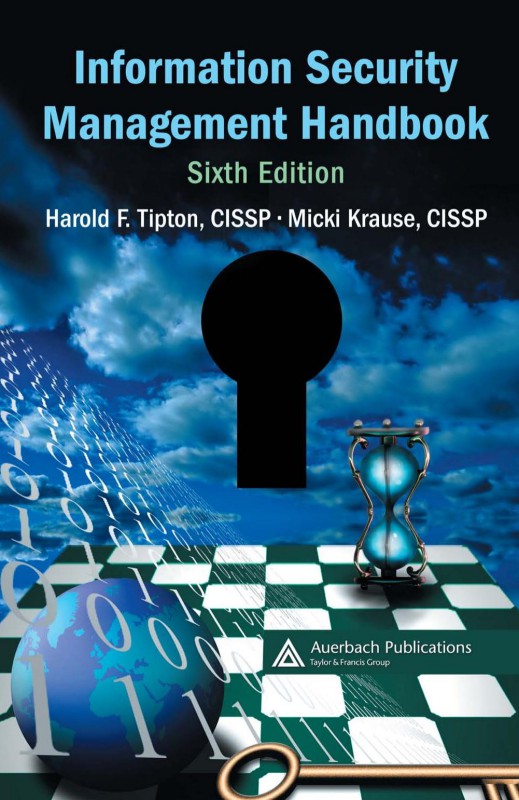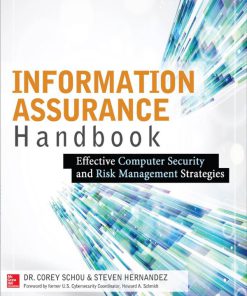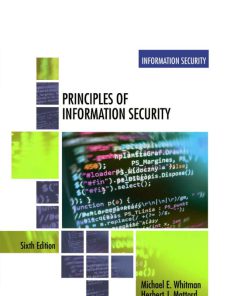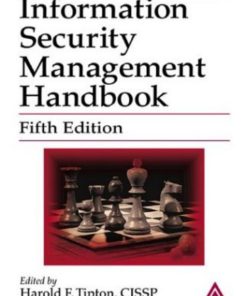Information security management handbook 6th Edition by Harold Tipton, Micki Krause ISBN 0849374952 9780849374955
$50.00 Original price was: $50.00.$25.00Current price is: $25.00.
Authors:kHarold F. Tipton, Micki Krause (editors) , Series:IT & Computer [535] , Author sort:kHarold F. Tipton, Micki Krause (editors) , Languages:Languages:eng , Published:Published:May 2007 , Publisher:Auerbach Publications
Information security management handbook 6th Edition by Harold F. Tipton, Micki Krause – Ebook PDF Instant Download/Delivery. 0849374952, 978-0849374951
Full download Information security management handbook 6th Edition after payment
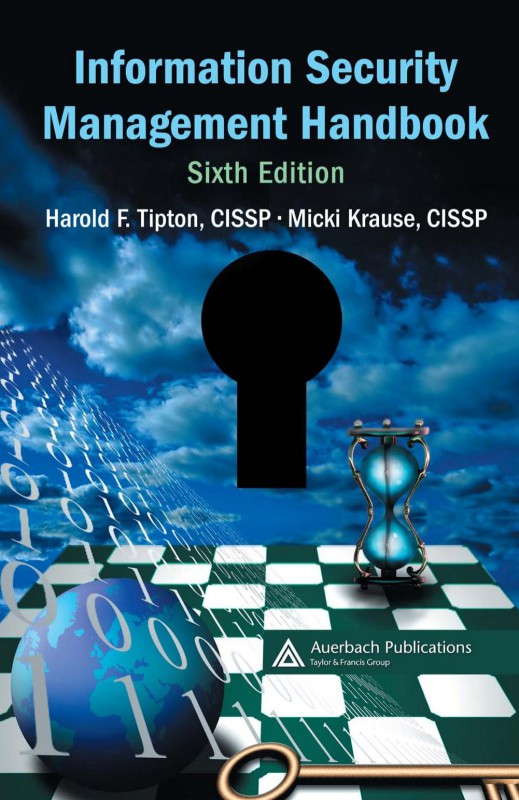
Product details:
ISBN 10: 0849374952
ISBN 13: 978-0849374951
Author: Harold F. Tipton, Micki Krause
Considered the gold-standard reference on information security, the Information Security Management Handbook provides an authoritative compilation of the fundamental knowledge, skills, techniques, and tools required of today’s IT security professional. Now in its sixth edition, this 3200 page, 4 volume stand-alone reference is organized under the CISSP Common Body of Knowledge domains and has been updated yearly. Each annual update, the latest is Volume 6, reflects the changes to the CBK in response to new laws and evolving technology.
Information security management handbook 6th Table of contents:
Domain I: Information Security and Risk Management
Chapter 1. Bits to Bytes to Boardroom
Chapter 2. Information Security Governance
Chapter 3. Corporate Governance
Chapter 4. IT Governance Institute (ITGI) Overview
Chapter 5. Top Management Support Essential for Effective Information Security
Chapter 6. Managing Security by the Standards: An Overview and Primer
Chapter 7. Information Security for Mergers and Acquisitions
Chapter 8. Information Security Governance
Chapter 9. Belts and Suspenders: Diversity in Information Technology Security
Chapter 10. Building Management Commitment through Security Councils, or Security Council Critical S
Chapter 11. Validating Your Business Partners
Chapter 12. Measuring ROI on Security
Chapter 13. The Human Side of Information Security
Chapter 14. Security Management
Chapter 15. It Is All about Control
Chapter 16. Patch Management 101: It Just Makes Good Sense!
Chapter 17. Security Patch Management: The Process
Chapter 18. Configuration Management: Charting the Course for the Organization
Chapter 19. Information Classification: A Corporate Implementation Guide
Chapter 20. Ownership and Custody of Data
Chapter 21. Information Security Risk Assessment
Chapter 22. Developing and Conducting a Security Test and Evaluation
Chapter 23. Enterprise Security Management Program
Chapter 24. Technology Convergence and Security: A Simplified Risk Management Model
Chapter 25. The Role of Information Security in the Enterprise Risk Management Structure
Chapter 26. A Matter of Trust
Chapter 27. Trust Governance in a Web Services World
Chapter 28. Risk Management and Analysis
Chapter 29. New Trends in Information Risk Management
Chapter 30. Cyber-Risk Management: Technical and Insurance Controls for Enterprise-Level Security
Chapter 31. Committee of Sponsoring Organizations (COSO)
Chapter 32. Toward Enforcing Security Policy: Encouraging Personal Accountablity for Corporate Infor
Chapter 33. The Security Policy Life Cycle: Functions and Responsibilities
Chapter 34. People, Processes, and Technology: A Winning Combination
Chapter 35. Building an Effective Privacy Program
Chapter 36. Establishing an E-Mail Retention Policy: Preventing Potential Legal Nightmares
Chapter 37. Ten Steps to Effective Web-Based Security Policy Development and Distribution
Chapter 38. Roles and Responsibilities of the Information Systems Security Officer
Chapter 39. Organizing for Success: Some Human Resources Issues in Information Security
Chapter 40. Information Security Policies from the Ground Up
Chapter 41. Policy Development
Chapter 42. Training Your Employees to Identify Potential Fraud and How to Encourage Them to Come Fo
Chapter 43. Change That Attitude: The ABCs of a Persuasive Security Awareness Program
Chapter 44. Maintaining Management’s Commitment
Chapter 45. Making Security Awareness Happen
Chapter 46. Beyond Information Security Awareness Training: It Is Time To Change the Culture
Chapter 47. Overview of an IT Corporate Security Organization
Chapter 48. Make Security Part of Your Company’s DNA
Chapter 49. Building an Effective and Winning Security Team
Chapter 50. When Trust Goes Beyond the Border: Moving Your Development Work Offshore
Chapter 51. Maintaining Information Security during Downsizing
Chapter 52. The Business Case for Information Security: Selling Management on the Protection of Vita
Chapter 53. How to Work with a Managed Security Service Provider
Chapter 54. Considerations for Outsourcing Security
Chapter 55. The Ethical and Legal Concerns of Spyware
Chapter 56. Ethics and the Internet
Chapter 57. Computer Ethics
Domain II: Access Control
Chapter 58. A Look at RFID Security
Chapter 59. New Emerging Information Security Technologies and Solutions
Chapter 60. Sensitive or Critical Data Access Controls
Chapter 61. An Introduction to Role-Based Access Control
Chapter 62. Smart Cards
Chapter 63. A Guide to Evaluating Tokens
Chapter 64. Controlling FTP: Providing Secured Data Transfers
Chapter 65. End Note Security and Network Access Management: Deciding Among Different Strategies
Chapter 66. Identity Management: Benefits and Challenges
Chapter 67. Blended Treat Analysis: Passwords and Policy
Chapter 68. Enhancing Security through Biometric Technology
Chapter 69. Single Sign-On for the Enterprise
Chapter 70. Centralized Authentication Services (RADIUS, TACACS, DIAMETER)
Chapter 71. An Introduction to Secure Remote Access
Chapter 72. Hacker Tools and Techniques
Chapter 73. A New Breed of Hacker Tools and Defenses
Chapter 74. Hacker Attacks and Defenses
Chapter 75. Counter-Economic Espionage
Chapter 76. Insight into Intrusion Prevention Systems
Chapter 77. Penetration Testing
Domain III Cryptography
Chapter 78. Auditing Cryptography: Assessing System Security
Chapter 79. Cryptographic Transitions
Chapter 80. Blind Detection of Steganographic Content in Digital Images Using Cellular Automata
Chapter 81. An Overview of Quantum Cryptography
Chapter 82. Elliptic Curve Cryptography: Delivering High-Performance Security for E-Commerce and Com
Chapter 83. Cryptographic Key Management Concepts
Chapter 84. Message Authentication
Chapter 85. Fundamentals of Cryptography and Encryption
Chapter 86. Steganography: The Art of Hiding Messages
Chapter 87. An Introduction to Cryptography
Chapter 88. Hash Algorithms: From Message Digests to Signatures
Chapter 89. A Look at the Advanced Encryption Standard (AES)
Chapter 90. Principles and Applications of Cryptographic Key Management
Chapter 91. Preserving Public Key Hierarchy
Chapter 92. PKI Registration
Chapter 93. Implementing Kerberos in Distributed Systems
Chapter 94. Methods of Attacking and Defending Cryptosystems
Domain IV: Physical (Environmental) Security
Chapter 95. Perimeter Security
Chapter 96. Melding Physical Security and Traditional Information Systems Security
Chapter 97. Physical Security for Mission-Critical Facilities and Data Centers
Chapter 98. Physical Security: A Foundation for Information Security
Chapter 99. Physical Security: Controlled Access and Layered Defense
Chapter 100. Computing Facility Physical Security
Chapter 101. Closed-Circuit Television and Video Surveillance
Chapter 102. Types of Information Security Controls
Chapter 103. Workplace Violence: Event Characteristics and Prevention
Chapter 104. Physical Security: The Threat after September 11, 2001
Domain V: Security Architecture and Design
Chapter 105. Enterprise Assurance: A Framework Explored
Chapter 106. Creating a Secure Architecture
Chapter 107. Common Models for Architecting an Enterprise Security Capability
Chapter 108. The Reality of Virtual Computing
Chapter 109. Formulating an Enterprise Information Security Architecture
Chapter 110. Security Architecture and Models
Chapter 111. The Common Criteria for IT Security Evaluation
Chapter 112. Common System Design Flaws and Security Issues
Domain VI: Business Continuity Planning and Disaster Recovery Planning
Chapter 113. Developing Realistic Continuity Planning Process Metrics
Chapter 114. Building Maintenance Processes for Business Continuity Plans
Chapter 115. Identifying Critical Business Functions
Chapter 116. Selecting the Right Business Continuity Strategy
Chapter 117. Contingency Planning Best Practices and Program Maturity
Chapter 118. Reengineering the Business Continuity Planning Process
Chapter 119. The Role of Continuity Planning in the Enterprise Risk Management Structure
Chapter 120. Contingency at a Glance
Chapter 121. The Business Impact Assessment Process and the Importance of Using Business Process Map
Chapter 122. Testing Business Continuity and Disaster Recovery Plans
Chapter 123. Restoration Component of Business Continuity Planning
Chapter 124. Business Resumption Planning and Disaster Recovery: A Case History
Chapter 125. Business Continuity Planning: A Collaborative Approach
Chapter 126. The Business Impact Assessment Process
Domain VII: Telecommunications and Network Security
Chapter 127. Network Security Utilizing an Adaptable Protocol Framework
Chapter 128. The Five W’s and Designing a Secure, Identity-Based, Self-Defending Network (5W Network
Chapter 129. Maintaining Network Security: Availability via Intelligent Agents
Chapter 130. PBX Firewalls: Closing the Back Door
Chapter 131. Network Security Overview
Chapter 132. Putting Security in the Transport: TLS
Chapter 133. WLAN Security Update
Chapter 134. Understanding SSL
Chapter 135. Packet Sniffers and Network Monitors
Chapter 136. Secured Connections to External Networks
Chapter 137. Security and Network Technologies
Chapter 138. Wired and Wireless Physical Layer Security Issues
Chapter 139. Network Router Security
Chapter 140. What’s Not So Simple about SNMP?
Chapter 141. Network and Telecommunications Media: Security from the Ground Up
Chapter 142. Security and the Physical Network Layer
Chapter 143. Wireless LAN Security Challenge
Chapter 144. ISO/OSI and TCP/IP Network Model Characteristics
Chapter 145. VoIP Security Issues
Chapter 146. An Examination of Firewall Architectures
Chapter 147. Voice over WLAN
Chapter 148. Spam Wars: How To Deal with Junk E-Mail
Chapter 149. Secure Web Services: Holes and Fillers
Chapter 150. IPSec Virtual Private Networks
Chapter 151. Internet Security: Securing the Perimeter
Chapter 152. Application-Layer Security Protocols for Networks
Chapter 153. Application Layer: Next Level of Security
Chapter 154. Security of Communication Protocols and Services
Chapter 155. An Introduction to IPSec
Chapter 156. VPN Deployment and Evaluation Strategy
Chapter 157. Comparing Firewall Technologies
Chapter 158. Cookies and Web Bugs: What They Are and How They Work Together
Chapter 159. Security for Broadband Internet Access Users
Chapter 160. Instant Messaging Security Issues
Chapter161. Voice Security
Chapter 162. Secure Voice Communications (VoI)
Chapter 163. Deep Packet Inspection Technologies
Chapter 164. Wireless Penetration Testing: Case Study and Countermeasures
Chapter 165. Auditing the Telephony System : Defenses against Communications Security Breaches and T
Chapter 166. Insecurity by Proxy
Chapter 167. Wireless Security
Chapter 168. Packet Sniffers: Use and Misuse
Chapter 169. ISPs and Denial-of-Service Attacks
Domain VIII: Application Security
Chapter 170. Application Service Provider Security: Ensuring a Secure Relationship for the Client an
Chapter 171. Stack-Based Buffer Overflows
Chapter 172. Web Application Security
Chapter 173. Security for XML and Other Metadata Languages
Chapter 174. XML and Information Security
Chapter 175. Application Security
Chapter 176. Covert Channels
Chapter 177. Security as a Value Enhancer in Application Systems Development
Chapter 178. Open Source versus Closed Source
Chapter 179. A Look at Java Security
Chapter 180. Reflections on Database Integrity
Chapter 181. Digital Signatures in Relational Database Applications
Chapter 182. Security and Privacy for Data Warehouses: Opportunity or Threat?
Chapter 183. Building and Assessing Security in the Software Development Lifecycle
Chapter 184. Avoiding Buffer Overflow Attacks
Chapter 185. Secure Development Life Cycle
Chapter 186. System Development Security Methodology
Chapter 187. Software Engineering Institute Capability Maturity Model
Chapter 188. Enterprise Security Architecture
Chapter 189. Certification and Accreditation Methodology
Chapter 190. System Development Security Methodology
Chapter 191. Methods of Auditing Applications
Chapter 192. Hacking Methods
Chapter 193. Enabling Safer Deployment of Internet Mobile Code Technologies
Domain IX: Operations Security
Chapter 194. Security Considerations in Distributed Computing: A Grid Security Overivew
Chapter 195. Managing Unmanaged Systems
Chapter 196. Storage Area Networks Security Protocols and Mechanisms
Chapter 197. Operations: The Center of Support and Control
Chapter 198. Why Today’s Security Technologies Are So Inadequate: History, Implications, and New App
Chapter 199. Operations Security and Controls
Chapter 200. The Nebulous Zero Day
Chapter 201. Understanding Service Level Agreements
Chapter 202. Physical Access Control
Chapter 203. Auditing the Electronic Commerce Environment
Domain X: Law, Compliance and Investigations
Chapter 204. Sarbanes-Oxley Compliance: A Technology Practitioner’s Guide
Chapter 205. Health Insurance Portability and Accounability Act Security Rule
Chapter 206. Jurisdictional Issues in Global Transmissions
Chapter 207. An Emerging Information Security Minimum Standard of Due Care
Chapter 208. ISPs and Accountability
Chapter 209. The Case for Privacy
Chapter 210. Liability for Lax Computer Security in DDoS Attacks
Chapter 211. Operational Forensics
Chapter 212. Computer Crime Investigation and Computer Forensics
Chapter 213. What Happened?
Chapter 214. Potential Cyber Terrorist Attacks
Chapter 215. The Evolutiont of the Sploit
Chapter 216. Computer Crime
Chapter 217. Phishing: A New Twist to an Old Game
Chapter 218. It’s All About Power: Information Warfare Tactics by Terrorists, Activists, and Miscrea
Chapter 219. Social Engineering: The Human Factor in Information Assurance
Chapter 220. Privacy Breach Incident Response
Chapter 221. Security Event Management
Chapter 222. DCSA: A Practical Approach to Digital Crime Scene Analysis
Chapter 223. What a Computer Security Professional Needs to Know about E-Discovery and Digital Foren
Chapter 224. How To Begin A Non-Liturgical Forensic Examination
Chapter 225. Honeypot Essentials
Chapter 226. Managing the Response to a Computer Security Incident
Chapter 227. Cyber-Crime: Response, Investigation, and Prosecution
People also search for Information security management handbook 6th:
information security management handbook volume 6
security incident information management handbook
what is isms information security management system
information security handbook a guide for managers
business information management pdf

